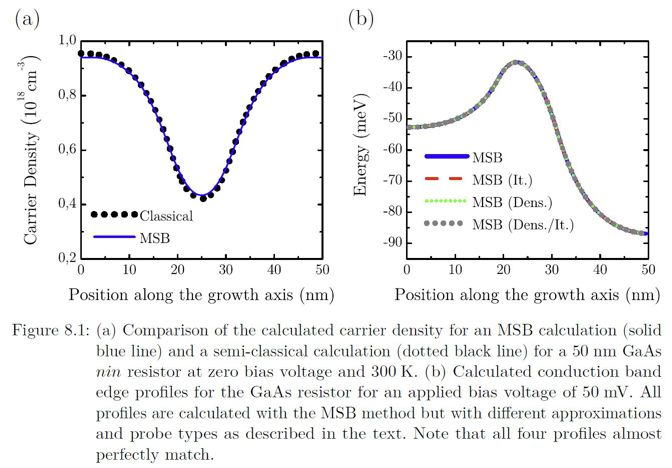Ballistic current calculation of a GaAs nin resistor
This tutorial is based on the following publications: [BirnerCBR2009], [GreckPhD2012]
The following input files were used:
Input files for nextnano³
1D_nin_symmetric_PhDthesis_PeterGreck_cl_zero_bias.inclassical calculation at zero bias, Fig. 8.1(a) of [GreckPhD2012]
1D_nin_symmetric_PhDthesis_PeterGreck.inCBR calculation of Fig. 8.1 and Fig. 8.2 of [GreckPhD2012]
1D_nin_symmetric_CBRpaper.inCBR calculation of Chapter 8.5 of [BirnerCBR2009], symmetric doping profile
1D_nin_asymmetric_CBRpaper.inCBR calculation of Chapter 8.5 of [BirnerCBR2009], asymmetric doping profile
Input files for nextnano.MSB
nin_resistor_PhDthesis_PeterGreck.xmlMSB calculation of Fig. 8.1 and Fig. 8.2 of [GreckPhD2012]
nin_resistor_CBRpaper_symmetric.xmlMSB calculation of Chapter 8.5 of [BirnerCBR2009], symmetric doping profile
nin_resistor_CBRpaper_asymmetric.xmlMSB calculation of Chapter 8.5 of [BirnerCBR2009], asymmetric doping profile
These example input files demonstrate how to calculate the ballistic current on a GaAs nin resistor. We use the same structure as outlined in Section 8.1 of [GreckPhD2012] and section 8.5 of [BirnerCBR2009] and compare the results obtained with the MSB method to the results obtained with the CBR method in nextnano++.
Example 1
The following figure shows the electron density and the conduction band edge profile for a 50 nm GaAs nin structure.

The following input files can be used to reproduce these results.
1D_nin_symmetric_PhDthesis_PeterGreck_cl_zero_bias.in(input file for nextnano³ code)classical calculation at zero bias, Fig. 8.1(a) of [GreckPhD2012]
1D_nin_symmetric_PhDthesis_PeterGreck.in(input file for nextnano³ code)CBR calculation of Fig. 8.1 and Fig. 8.2 of [GreckPhD2012]
nin_resistor_PhDthesis_PeterGreck.xml(input file nextnano.MSB)MSB calculation of Fig. 8.1 and Fig. 8.2 of [GreckPhD2012]
The MSB results are very similar to the CBR results (not shown). Note that the CBR method uses an adaptive energy grid
adaptive-energy-grid = adaptive-exponential
to improve convergence while the MSB method uses a constant energy grid spacing.
The following results of the CBR input files are consistent to the MSB results for both, zero bias and nonzero bias. This has been checked.
conduction band edges
electric field
electron density and energy resolved electron density
DOS, position resolved DOS, lead resolved DOS (although the numbers are slightly different but the energy grid is also slightly different, i.e. nonuniform (CBR) vs. uniform (MSB) energy grid)
Transmission
IV curve
Example 2
The following input files can be used to reproduce the results of section 8.5 of [BirnerCBR2009].
1D_nin_symmetric_CBRpaper.in(input file for nextnano³ code)CBR calculation of Chapter 8.5 of [BirnerCBR2009], symmetric doping profile
1D_nin_asymmetric_CBRpaper.in(input file for nextnano³ code)CBR calculation of Chapter 8.5 of [BirnerCBR2009], asymmetric doping profile
nin_resistor_CBRpaper_symmetric.xml(input file for nextnano.MSB)MSB calculation of Chapter 8.5 of [BirnerCBR2009], symmetric doping profile
nin_resistor_CBRpaper_asymmetric.xml(input file for nextnano.MSB)MSB calculation of Chapter 8.5 of [BirnerCBR2009], asymmetric doping profile
Again, we obtained very good agreement between the CBR and the MSB algorithm.
Important comment
Here, we had to use more energy grid points compared to the CBR code (where we used 300) in order to obtain convergence.
Nodes = 501 # Comment = Number of energy grid points.
We noticed this because the number of outer Poisson iterations exceeded its maximum as can be seen in the .log file
Poisson iteration 60
The number of outer Poisson iterations should be increased as follows.
MaxPoissonOuterIts = 60 # Comment = Max. outer Poisson iterations where G^R is recalculated.
Further comments regarding the MSB input file
In order to calculate the current ballistically we switched of scattering by using the following flag.
BallisticCalculation = yes
Last update: 03/04/2025